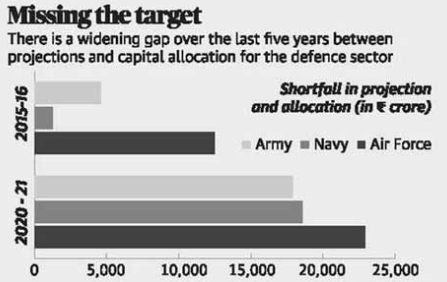SHORTFALL – DEFENCE FUND
17, Mar 2020

Prelims level : Infrastructure Road, inland, Railway aviation, Housing, Rural & Urban
Mains level : GS-III Infrastructure: Energy, Ports, Roads, Airports, Railways, etc
Why in News?
- Parliamentary Standing Committee on Defence has recently shown concern at the widening gap between projections and allocations in the defence budget.
Key Findings of the Committee
- It noted that since 2015-16, none of the three Services (Army, Navy and Air Force) has been given the matching allocation as per the projection. There is a considerable shortage in the allocation in the Capital Head, which is 35% less than the projection.
- It noted that the committedliabilities constitute a significant part of the Capital Head and inadequate allocation would definitely lead to ‘default situation’ on contractual obligations. They are payments anticipated during a financial year for contracts concluded in previous years.
- It opines that such a situation is not conducive for preparation of the country to modern-day warfare, where possession of capital intensive modern machines is a prerequisite for tilting the result of the war in favour and also to have a credible deterrence.
- Both the Navy and the Indian Air Force (IAF) have a situation where their committed liabilities are more than their share of the capital allocation in the Budget.
- To offset this, the Services have been forced to defer payment of committed liabilities of the Defence Public Sector Undertakings (DPSU) among other measures.

The shortfall in Defence Expenditure will Affect:
- Operational readiness of Andaman and Nicobar Command (ANC).
- Maintenance of SIGINT (Signal Intelligence) equipment.
- Administration of training institutes and operational units.
- Operationalisation of three tri-service organizations i.e. Defence Space Agency (DSA), Defence Cyber Agency (DCYA) and Armed Forces Special Operations Division (AFSOD).
Recommendations of the Committee:
- It has recommended a dedicated fund for committed liabilities and procurements before the shortfall impacts modernisation, invariably from next Budget onwards (2021-22)






